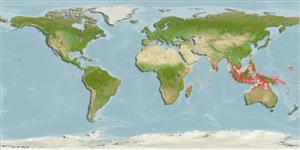(كوسه ها و سپرماهيان) (sharks and rays) >
Myliobatiformes (Stingrays) >
Gymnuridae (Butterfly rays)
Etymology: Gymnura: Greek, gymnos = naked + Greek, oura = tail (Ref. 45335).
More on author: Bleeker.
Environment: milieu / climate zone / depth range / distribution range
بوم شناسي
دريايي وابسته به آب سنگ; تغييرات عمق 28 - 37 m (Ref. 9918). Tropical
Eastern Indian Ocean and Western Central Pacific: India to Indonesia, including Singapore and Thailand.
Length at first maturity / Size / Weight / سن
Maturity: Lm 47.6, range 47 - ? cm
Max length : 106 cm WD جنس نر / بدون خواص جنسي; (Ref. 58048); common length : 20.0 cm WD جنس نر / بدون خواص جنسي; (Ref. 27550)
Demersal inshore, in shallow depths to at least 37 m (Ref.58048). Also found offshore (Ref. 9918). Ovoviviparous (Ref. 50449). Smallest individual was 27 cm WD. Caught often by demersal trawl, trammel and gillnet fisheries, and occasionally using tangle nets. Utilized for its meat, but of limited value due to its typically small size (Ref.58048).
Life cycle and mating behavior
Maturities | تولید مثل | Spawnings | Egg(s) | Fecundities | توزاد ( لارو)
Exhibit ovoviparity (aplacental viviparity), with embryos feeding initially on yolk, then receiving additional nourishment from the mother by indirect absorption of uterine fluid enriched with mucus, fat or protein through specialised structures (Ref. 50449). Distinct pairing with embrace (Ref. 205).
Compagno, L.J.V., 1999. Checklist of living elasmobranchs. p. 471-498. In W.C. Hamlett (ed.) Sharks, skates, and rays: the biology of elasmobranch fishes. Johns Hopkins University Press, Maryland. (Ref. 35766)
وضعيت در فهرست قرمز IUCN (Ref. 130435)
استفاده انسانی
ماهي گيري – شيلات: تجاري
ابزارها
گزارش های ويژه
بارگيری XML
منابع اينترنتي
Estimates based on models
Preferred temperature (Ref.
123201): 27.2 - 28.8, mean 28.2 °C (based on 91 cells).
Phylogenetic diversity index (Ref.
82804): PD
50 = 0.5000 [Uniqueness, from 0.5 = low to 2.0 = high].
Bayesian length-weight: a=0.00776 (0.00352 - 0.01710), b=3.09 (2.89 - 3.29), in cm total length, based on LWR estimates for this (Sub)family-body shape (Ref.
93245).
Trophic level (Ref.
69278): 3.8 ±0.6 se; based on size and trophs of closest relatives
جهندگی (Ref.
120179): خیلی آهسته, كمينه زمان لازم براي دو برابر شدن جمعيت بيش از 14 سال (Fec assumed to be <10).
Fishing Vulnerability (Ref.
59153): Moderate to high vulnerability (51 of 100).
